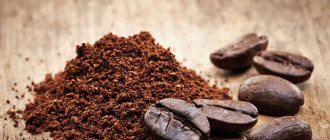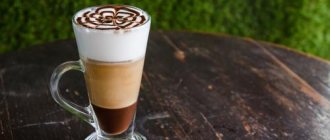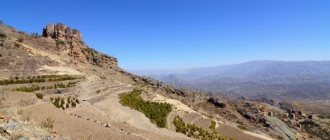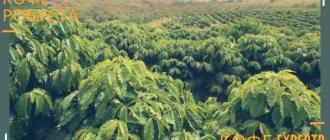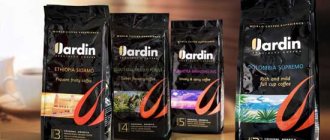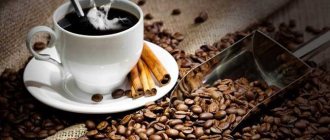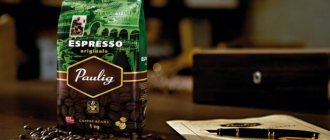Coffee from the Dominican Republic: interesting facts
It all started back in the 18th century, when Spanish colonists brought seedlings of coffee trees to the island from the island of Martinique. Since then, coffee plantations have grown rapidly, and now they can be found in various parts of the Dominican Republic. The most extensive plantations grow in the provinces of Barahona, Azua, Bani, Moca, Barouco, as well as in the Cibao Valley.
On our website you can purchase wonderful excursions in the Dominican Republic!
Book excursions
In the highlands of the country, only the highest grade of Arabica is grown. True coffee lovers know that Dominican coffee is considered one of the best in the world, and invariably prefer this exquisite drink. All Dominican coffee beans are rich in oils and are also rich in caffeine. There is even a special association in the country, ADOCAFES, which is involved in assessing the taste of coffee, as well as improving new varieties.
Coffee trees of the tipica subspecies, which make up 90% of Dominican coffee, are quite capricious, but at the same time, traditionally have high quality indicators. They are grown at altitudes from 600 to 1450 meters. Due to the diversity of the island's microclimate, coffee is harvested almost all year round in the Dominican Republic. But the most productive months are July and August.
Climate and growing conditions for coffee trees
The tropical humid climate of the Dominican Republic, as well as a large number of areas located high in the mountains, promotes the growth of Arabica Typica coffee trees.
This is one of the oldest varieties that spread around the world from Ethiopia. Some of them have mutated because they were exposed to different soil and climate, but still produce an excellent harvest. Typica grains are distinguished by their regular shape and large size.
Mountain soils and less oxygen in the atmosphere allow the grains to take longer to fill and ripen, so they are heavier than those that grow on the plains or in forests and have a deeper taste with a variety of shades. Therefore, the Dominicans produce a single variety for export, which has something to boast about in terms of taste. Blends are produced here in small quantities - mainly for personal use.
Interesting! There are also two large factories producing elite rum in the Dominican Republic. You can buy a bottle for $30
It is believed that Christopher Columbus was the first to plant coffee beans when he discovered America. Most likely, this is not the case and the traveler did not intend to engage in tree cultivation. Arabica did not immediately take root in the Dominican Republic. It took about 500 years the trees to take root in the new location.
To prevent the sun from drying out the plantations during the hot season, coffee in the Dominican Republic grows under the shade of taller trees - nuts, bananas, palm trees. The harvest is harvested throughout the year, as the climate here is warm - at the coldest time the temperature stays at 22 degrees, dropping to 18 at night.
Coffee production technology
Typically, coffee trees reach no more than four meters in height, with each tree producing approximately 4 kilograms of fruit per year. After roasting the beans, 1 kilogram of the finished product is obtained. Coffee trees are magnificent when they are in flower. In addition, flowers exude a subtle, pleasant aroma. As coffee berries ripen, they change color from green to red, and then to dark burgundy. A ripe coffee berry contains 2 coffee beans.
After ripening, the fruits are carefully picked by hand, washed in water, dried, peeled, and then sent to producers. Some farmers pre-roast the grains themselves.
If you are interested in seeing with your own eyes the process of growing and processing coffee, you can go on one of the excursions in the Dominican countryside, the route of which includes a visit to a Dominican ranch. Local residents will take you around their property, showing you how coffee, cocoa, tobacco, mangoes, bananas, pineapples, and many other crops grow.
ON OUR WEBSITE YOU CAN PURCHASE WONDERFUL EXCURSIONS IN THE DOMINICAN CAN, CLICK AND FIND OUT DETAILS!
A long way from plantation to cup
Arabica beans are mainly grown in the Dominican Republic. The largest coffee plantations are located in the provinces of Baoruko, Azua, Peravia, and Espaillat.
But the coffee grown near Jarabacoa is most valued by connoisseurs. This is a mountainous region of the country, so coffee trees grow here on fairly steep slopes, which makes the use of technology very difficult. Almost the entire process of caring for and harvesting is carried out the old fashioned way - by hand.
The seedlings are grown in special nurseries and only after reaching a certain height are they planted in clay mountain soil. Upon reaching the age of three, young trees begin to bear fruit. What’s interesting: the berries ripen gradually, acquiring a bright red color. That is, pickers collect only ripe fruits, leaving green ones on the branches. As a result, the same slope has to be climbed several times. It’s difficult, but it is the duration and non-simultaneous ripening that gives high-mountain coffee beans from the Dominican Republic such a unique taste.
Coffee berry ( planters call it “cherry”
) covered with pulp. Inside there is either one grain separated by a longitudinal groove, or two segments adjacent to each other.
Coffee reaches processing plants in the form of “cherries”. There, the fruits are dried in the sun for 1-2 months, then cleaned of fragile pulp residues by machine. Sometimes special dryers are used, where grains are exposed to temperatures of +50-60 degrees. But there is also a “wet” method of processing grains. In this case, the berries are passed through special washing machines to remove the pulp, and then dried. Sun-dried coffee is considered to be of the highest quality. Imagine, during the day each grain needs to be turned over 8-20 times, depending on the stage of drying!
After drying, the stage of peeling and cleaning the grains from unwanted impurities and all kinds of debris begins. And only after this the coffee is thoroughly roasted.
Ready-made coffee is packaged depending not only on the variety, but also on the size of the beans. The largest grains are marked with the letters AA and are more expensive than others.
Coffee culture: Dominican traditions
Absolutely all residents of the Dominican Republic are real coffee lovers. By the way, there is no culture of drinking tea on the island, as such. And you can’t find or buy good tea either. But there is plenty of coffee to suit every taste and budget.
Dominicans themselves drink coffee at any time of the day. It is usually prepared in special geyser coffee makers and then poured into small cups. The coffee is very strong, and locals always generously add sugar to it.
The fact is that Dominicans also have a terrible sweet tooth. Sometimes the drink even resembles coffee syrup. Therefore, when buying a cup of coffee in the Dominican Republic, ask for sugar separately - sin azukar. Also popular in the Dominican Republic is coffee with milk – café con leche.
Chocolate
What is definitely worth bringing back from the Dominican Republic is chocolate, which, moreover, is one of the favorite delicacies of Dominicans. Therefore, almost all desserts on the island are prepared from it. You can buy different varieties here, but the most popular are Cortés Hermanos & Co, Xocolat, Munné & Co.
Cost starts from 1 dollar.
Chocolate tea is especially popular among the local population. No, it's not the same as hot chocolate. It tastes different. To prepare such a drink, special powders and sticks are sold. One package can be purchased for as little as $8.
Dominican coffee varieties
Santo Domingo and Induban coffee are the most popular brands
One of the largest coffee producers in the Dominican Republic is the Induban factory. It produces the most popular and most affordable Santo Domingo coffee, as well as the slightly more expensive Induban, which combines Typica and bourbon.
Santo Domingo coffee is sold almost everywhere, both ground and beans. It is best suited for making espresso in a Turk or geyser coffee maker. Despite the low price, this is high quality coffee that has a pleasant taste and rich aroma. As for Induban coffee, it is a drink with a thicker and tart taste.
Monte Real – finely ground coffee
Keep in mind that you are unlikely to find instant coffee in the Dominican Republic. And in general, this is a very dubious drink that has almost nothing in common with real coffee. However, if you are used to preparing coffee in a hurry when you don’t have time to brew it, the Monte Real variety is suitable for you. This coffee is very finely ground, so you can safely simply brew it in a mug with boiling water. But it is better, of course, to cook it according to all the rules - over low heat until it boils. This drink has a mild taste and chocolate aroma.
Barahona and other varieties
It is not only the Santa Domingo variety that keeps the country's coffee industry alive. There are other decent examples of coffee here.
The second most popular variety in the Dominican Republic. It is grown at an altitude of 700 to 1300 meters above sea level. The trees are protected by the crowns of their nut and fruit counterparts from the scorching sun. The finished drink has low acidity, a rich chocolate-prune base, savory notes of nuts and spices, warm tones of caramel and tobacco.
Monte Alto
The variety grows relatively low at an altitude of 700-1700 meters. There are two main varieties - Espresso and Premium. The first one has a strong roast and is intended for preparation in automatic coffee machines. The second is more delicate, has a medium roast, and is suitable for manual cooking. The variety is distinguished by a warm flavor range, in which nutty, chocolate and earthy shades are felt, and there is almost no sourness.
Monte Real
Distributed in the Dominican Republic itself. It is sold already in ground form. The grind is very fine, well suited for popular hand-cooking options. The flavor profile of the drink is chocolate and cocoa with notes of prunes and nuts. Like most varieties of Dominican coffee, Monte Rial is distinguished by its strength and high caffeine content.
Green coffee is a drink for those who care about their health and figure
Those who watch their figure and want to lose weight should pay attention to green coffee from the Dominican Republic. This coffee does not have a pronounced taste and aroma, but it is considered very healthy due to its antioxidant properties, as well as the content of chlorogenic acid, which promotes fat burning.
It is believed that green coffee increases mental and physical activity, perfectly tones, and also helps with headaches. In stores it is easily recognized by its bright packaging, which depicts green coffee beans.
How much does coffee cost in the Dominican Republic?
Coffee prices can vary depending on the size of the package and the type of grind. Also, the cost of coffee may vary in different stores. We present the order of prices for different types of coffee in the Dominican Republic:
- Coffee Santo Domingo - 4-9 dollars per package
- Induban Coffee - $8 per pack
- Coffee Monte Real - $7-14 per package
- Coffee Cibao, Barahona, Bani, Okoa, Monte Alto, Café Caribeño - about $15 per package
- Coffee Don Rogerio (Don Rogerio Blend and Arom) - from $16 per package
- Coffee Don Justino - from $16 per package
- Green coffee – 7 – 17 dollars per package
Types of coffee Santo Domingo
- Santo Domingo (briquette 453.6 g) – 100% Arabica (Typica), roast – medium. The coffee is fragrant with apple and grapes; the taste is dominated by vanilla-caramel and chocolate shades. The sourness is very weak;
- Santo Domingo Aroma (briquette 453.6 g) – 100% Arabica. Sweetish notes in the taste soften the coffee bitterness;
- Induban Gourmet (453.6 g briquette) – 100% Arabica (a mixture of bourbon and typica), medium roast. The coffee has a floral flavor.
- Santo Domingo (briquettes 453.6 g, 226 g, tin 283 g);
- Santo Domingo Espresso (briquette 453.6 g) – 100% Arabica (typica), medium roast, low acidity;
- Induban Gourmet (briquettes 453.6 g, 226 g, tin 283 g);
- Santo Domingo Descafeinado (283 g tin) – decaffeinated Arabica.
Where to buy Dominican coffee?
In the resort area, in regular stores and even in large supermarkets, only the most popular types of coffee are found: Santo Domingo and Induban. To have a large selection of coffee varieties, it is best to go to special tourist shops. There are quite a lot of them both in the resort area of Punta Cana and in the colonial part of the city of Santo Domingo, the capital of the Dominican Republic.
Sometimes you can buy coffee at the ranch, where you stop on some excursions. But keep in mind that in “home production” no one monitors the quality, and sometimes such coffee has a slightly “burnt” taste.
